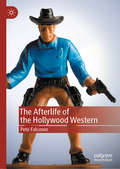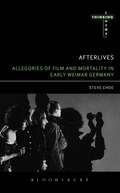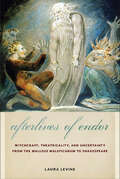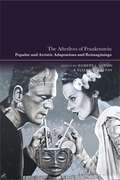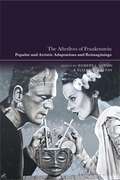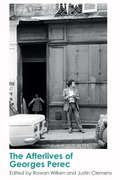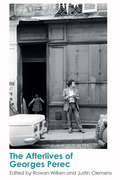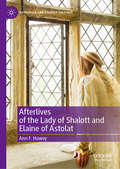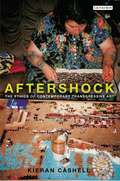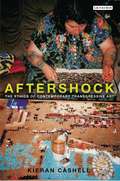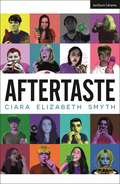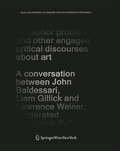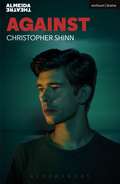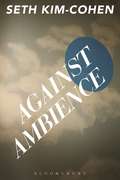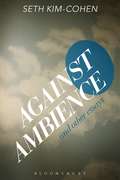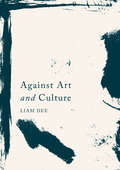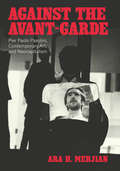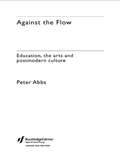- Table View
- List View
The Afterlife of the Hollywood Western
by Pete FalconerThis book examines the Western genre in the period since Westerns ceased to be a regular feature of Hollywood filmmaking. For most of the 20th Century, the Western was a major American genre. The production of Westerns decreased in the 1960s and 1970s; by the 1980s, it was apparent that the genre occupied a less prominent position in popular culture. After an extended period as one of the most prolific Hollywood genres, the Western entered its “afterlife”. What does it now mean for a Hollywood movie to be a Western, and how does this compare to the ways in which the genre has been understood at other points in its history? This book considers the conditions in which the Western has found itself since the 1980s, the latter-day associations that the genre has acquired and the strategies that more recent Westerns have developed in response to their changed context.
Afterlives: Allegories Of Film And Mortality In Early Weimar Germany (Thinking Cinema)
by Steve ChoeWeimar cultural critics and intellectuals have repeatedly linked the dynamic movement of the cinema to discourses of life and animation. Correspondingly, recent film historians and theorists have taken up these discourses to theorize the moving image, both in analog and digital. But, many important issues are overlooked. Combining close readings of individual films with detailed interpretations of philosophical texts, all produced in Weimar Germany immediately following the Great War, Afterlives: Allegories of Film and Mortality in Early Weimar Germany shows how these films teach viewers about living and dying within a modern, mass mediated context. Choe places relatively underanalyzed films such as F. W. Murnau's The Haunted Castle and Arthur Robison's Warning Shadows alongside Martin Heidegger's early seminars on phenomenology, Sigmund Freud's Reflections upon War and Death and Max Scheler's critique of ressentiment. It is the experience of war trauma that underpins these correspondences, and Choe foregrounds life and death in the films by highlighting how they allegorize this opposition through the thematics of animation and stasis.
Afterlives: Allegories Of Film And Mortality In Early Weimar Germany (Thinking Cinema)
by Steve ChoeWeimar cultural critics and intellectuals have repeatedly linked the dynamic movement of the cinema to discourses of life and animation. Correspondingly, recent film historians and theorists have taken up these discourses to theorize the moving image, both in analog and digital. But, many important issues are overlooked. Combining close readings of individual films with detailed interpretations of philosophical texts, all produced in Weimar Germany immediately following the Great War, Afterlives: Allegories of Film and Mortality in Early Weimar Germany shows how these films teach viewers about living and dying within a modern, mass mediated context. Choe places relatively underanalyzed films such as F. W. Murnau's The Haunted Castle and Arthur Robison's Warning Shadows alongside Martin Heidegger's early seminars on phenomenology, Sigmund Freud's Reflections upon War and Death and Max Scheler's critique of ressentiment. It is the experience of war trauma that underpins these correspondences, and Choe foregrounds life and death in the films by highlighting how they allegorize this opposition through the thematics of animation and stasis.
Afterlives of Endor: Witchcraft, Theatricality, and Uncertainty from the "Malleus Maleficarum" to Shakespeare
by Laura LevineAfterlives of Endor offers an analysis of the way early modern English literature addressed the period's anxieties about witchcraft and theatricality. What determined whether or not a demonologist imagined a trial as a spectacle? What underlying epistemological constraints governed such choices and what conceptions of witchcraft did these choices reveal? Pairing readings of demonological texts with canonical plays and poetry, Laura Levine examines such questions. Through analyses of manuals and pamphlets about the prosecution of witches—including Reginald Scot's skeptical The Discoverie of Witchcraft (1584), King James VI/I's Daemonologie (1597), and Jean Bodin's De la Demonomanie des Sorciers (1580)—Afterlives of Endor examines the way literary texts such as Shakespeare's The Winter's Tale and The Tempest, Spenser's The Faerie Queene, and Marlowe's Tragicall History of Doctor Faustus address anxieties about witchcraft, illusion, and theatricality. Afterlives of Endor attends to the rhetorical tactics, argumentative investments, and underlying tensions of demonological texts with the scrutiny ordinarily reserved for literary texts.
The Afterlives of Frankenstein: Popular and Artistic Adaptations and Reimaginings
by Robert I. Lublin and Elizabeth A. FayAn exploration of the treatment of Mary Shelley's Frankenstein in popular art and culture, this book examines adaptations in film, comics, theatre, art, video-games and more, to illuminate how the novel's myth has evolved in the two centuries since its publication. Divided into four sections, The Afterlives of Frankenstein considers the cultural dialogues Mary Shelley's novel has engaged with in specific historical moments; the extraordinary examples of how Frankenstein has suffused our cultural consciousness; and how the Frankenstein myth has become something to play with, a locus for reinvention and imaginative interpretation. In the final part, artists respond to the Frankenstein legacy today, reintroducing it into cultural circulation in ways that speak creatively to current anxieties and concerns.Bringing together popular interventions that riff off Shelley's major themes, chapters survey such works as Frankenstein in Baghdad, Bob Dylan's recent “My Own Version of You”, the graphic novel series Destroyer with its Black cast of characters, Jane Louden's The Mummy!, the first Japanese translation of Frankenstein, “The New Creator”, the iconic Frankenstein mask and Kenneth Brannagh's Mary Shelley's Frankenstein film. A deep-dive into the crevasses of Frankenstein adaptation and lore, this volume offers compelling new directions for scholarship surrounding the novel through dynamic critical and creative responses to Shelley's original.
The Afterlives of Frankenstein: Popular and Artistic Adaptations and Reimaginings
An exploration of the treatment of Mary Shelley's Frankenstein in popular art and culture, this book examines adaptations in film, comics, theatre, art, video-games and more, to illuminate how the novel's myth has evolved in the two centuries since its publication. Divided into four sections, The Afterlives of Frankenstein considers the cultural dialogues Mary Shelley's novel has engaged with in specific historical moments; the extraordinary examples of how Frankenstein has suffused our cultural consciousness; and how the Frankenstein myth has become something to play with, a locus for reinvention and imaginative interpretation. In the final part, artists respond to the Frankenstein legacy today, reintroducing it into cultural circulation in ways that speak creatively to current anxieties and concerns.Bringing together popular interventions that riff off Shelley's major themes, chapters survey such works as Frankenstein in Baghdad, Bob Dylan's recent “My Own Version of You”, the graphic novel series Destroyer with its Black cast of characters, Jane Louden's The Mummy!, the first Japanese translation of Frankenstein, “The New Creator”, the iconic Frankenstein mask and Kenneth Brannagh's Mary Shelley's Frankenstein film. A deep-dive into the crevasses of Frankenstein adaptation and lore, this volume offers compelling new directions for scholarship surrounding the novel through dynamic critical and creative responses to Shelley's original.
The Afterlives of Georges Perec
by Rowan Wilken Justin ClemensThese 14 essays examine Georges Perec's impact on architecture, art, design, media, electronic communications, computing and the everyday.
The Afterlives of Georges Perec
by Rowan Wilken Justin ClemensThese 14 essays examine Georges Perec's impact on architecture, art, design, media, electronic communications, computing and the everyday.
Afterlives of the Lady of Shalott and Elaine of Astolat (Arthurian and Courtly Cultures)
by Ann F. HoweyThis book investigates adaptations of The Lady of Shalott and Elaine of Astolat in Victorian and post-Victorian popular culture to explore their engagement with medievalism, social constructions of gender, and representations of the role of art in society. Although the figure of Elaine first appeared in medieval texts, including Malory’s Le Morte Darthur, Tennyson’s poems about the Lady and Elaine drew unprecedented response from musicians, artists, and other authors, whose adaptations in some cases inspired further adaptations. With chapters on music, art, and literature (including parody, young people’s literature, and historical fiction and fantasy), this book seeks to trace the evolution of these characters and the ways in which they reinforce or challenge conventional gender roles, represent the present’s relationship to the past, and highlight the power of art.
The Aftermaths of Participation: Outcomes and Consequences of Participatory Work with Forced Migrants in Museums (Edition Museum #67)
by Susanne BoersmaHow do participatory museum projects with forced migrants impact both the museum and the participants? What happens during these projects and what is left of them afterwards? Based on interviews with museum practitioners, facilitators and project participants, Susanne Boersma brings together unique insights into museum work with forced migrants. Her study of participatory projects in Germany, the Netherlands and the UK reveals museums' limiting infrastructures, the shortcomings of their ethical frameworks, and the problems of addressing forced migrants as 'communities'. Outlining the diverging objectives, experiences and outcomes of participatory projects, she suggests how these might be united in practice.
Aftershock: The Ethics of Contemporary Transgressive Art
by Kieran CashellAccused by the tabloid press of setting out to 'shock', controversial artworks are vigorously defended by art critics, who frequently downplay their disturbing emotional impact. This is the first book to subject contemporary art to a rigorous ethical exploration. It argues that, in favouring conceptual rather than emotional reactions, commentators actually fail to engage with the work they promote. Scrutinising notorious works by artists including Damien Hirst, Jake and Dinos Chapman, Richard Billingham, Marc Quinn, Sally Mann, Marcus Harvey, Hans Bellmer, Paul McCarthy, Tierney Gearon, and Tracey Emin, "Aftershock" insists on the importance of visceral, emotional and 'ethical' responses. Far from clouding our judgement, Cashell argues, shame, outrage or revulsion are the very emotions that such works set out to evoke. While also questioning the catch-all notion of 'transgression', this illuminating and controversial book neither jumps indiscriminately to the defence of shocking artworks nor dismisses them out of hand.
Aftershock: The Ethics of Contemporary Transgressive Art
by Kieran CashellAccused by the tabloid press of setting out to 'shock', controversial artworks are vigorously defended by art critics, who frequently downplay their disturbing emotional impact. This is the first book to subject contemporary art to a rigorous ethical exploration. It argues that, in favouring conceptual rather than emotional reactions, commentators actually fail to engage with the work they promote. Scrutinising notorious works by artists including Damien Hirst, Jake and Dinos Chapman, Richard Billingham, Marc Quinn, Sally Mann, Marcus Harvey, Hans Bellmer, Paul McCarthy, Tierney Gearon, and Tracey Emin, 'Aftershock' insists on the importance of visceral, emotional and 'ethical' responses. Far from clouding our judgement, Cashell argues, shame, outrage or revulsion are the very emotions that such works set out to evoke. While also questioning the catch-all notion of 'transgression', this illuminating and controversial book neither jumps indiscriminately to the defence of shocking artworks nor dismisses them out of hand.'Kieran Cashell discusses artists who use everything from soiled bed linens to blood to dead sharks in their works. Drawing on an impressive array of philosophical ideas, Cashell helps viewers tackle the messy details of art by Damien Hirst, Orlan, Marc Quinn, Tracy Emin, and more, as he provides a probing and subtle defense of the moral value of such recent "transgressive" art.'- Cynthia A. Freeland Professor and Chair, Department of Philosophy University of Houston, Texas
Aftertaste (Modern Plays)
by Ciara Elizabeth SmythIn an alternate Ireland, the politicians are young and the Government is seemingly left-leaning. The Health and Wellness Act, hurriedly signed into law just one year ago, has made it illegal to possess or consume unhealthy food or 'junk'. Recent polls suggest support for 'Junk Advocates', a term coined for people who openly acquire and consume illegal foods in protest, is rapidly rising. So when popular 'Junk Advocate' Lila Birch goes missing under suspicious circumstances, the public are outraged and her sister Eadie's world is upended. When Eadie sees an opportunity to get close to high ranking Government officials, she takes it. Can she find out what happened to her sister or will the same fate befall her?Aftertaste is a new play by Ciara Elizabeth Smyth that offers a theatrical exploration into a world full of violence, greed and food.
Aftertaste (Modern Plays)
by Ciara Elizabeth SmythIn an alternate Ireland, the politicians are young and the Government is seemingly left-leaning. The Health and Wellness Act, hurriedly signed into law just one year ago, has made it illegal to possess or consume unhealthy food or 'junk'. Recent polls suggest support for 'Junk Advocates', a term coined for people who openly acquire and consume illegal foods in protest, is rapidly rising. So when popular 'Junk Advocate' Lila Birch goes missing under suspicious circumstances, the public are outraged and her sister Eadie's world is upended. When Eadie sees an opportunity to get close to high ranking Government officials, she takes it. Can she find out what happened to her sister or will the same fate befall her?Aftertaste is a new play by Ciara Elizabeth Smyth that offers a theatrical exploration into a world full of violence, greed and food.
Again the Metaphor Problem and Other Engaged Critical Discourses about Art: A Conversation between John Baldessari, Liam Gillick and Lawrence Weiner, moderated by Beatrix Ruf (Kunst und Architektur im Gespräch Art and Architecture in Discussion)
by John Baldessari Liam Gillick Lawrence Weiner Beatrix RufSeit Beginn ihrer Karrieren in den 1960er Jahren sind die amerikanischen Künstler John Baldessari und Lawrence Weiner befreundet. In New York treffen sie den britischen Künstler Liam Gillick zu dem von Beatrix Ruf, Direktorin der Kunsthalle Zürich, moderierten Gespräch. Die Metapher, seit jeher als künstlerisches Verfahren in Verwendung, ist ein wichtiges Problem im Werk dieser drei Künstler, die mit Sprache, Filmbildern und Installationen arbeiten. Im Gespräch eröffnen sich neue Erkenntnisse über die Metapher, über die Funktion der Kunst, über Architektur und über die Rollen und Interessen der Künstler und der Vermittler von Kunst. Ein Gespräch über die Kunstwelt und die Kunst in der Welt.
Against (Modern Plays)
by Christopher ShinnGo where there's violence. Silicon Valley. The future. A rocket launches. Luke is an aerospace billionaire who can talk to anyone. But God is talking to him. He sets out to change the world. Only violence stands in his way.Christopher Shinn's gripping play received its world premiere at the Almeida Theatre on 12 August 2017 in a production directed by Ian Rickson and featuring Ben Whishaw as Luke.
Against (Modern Plays)
by Christopher ShinnGo where there's violence. Silicon Valley. The future. A rocket launches. Luke is an aerospace billionaire who can talk to anyone. But God is talking to him. He sets out to change the world. Only violence stands in his way.Christopher Shinn's gripping play received its world premiere at the Almeida Theatre on 12 August 2017 in a production directed by Ian Rickson and featuring Ben Whishaw as Luke.
Against Ambience
by Seth Kim-CohenAgainst Ambience diagnoses - in order to cure - the art world's recent turn toward ambience. Over the course of three short months - June to September, 2013 - the four most prestigious museums in New York indulged the ambience of sound and light: James Turrell at the Guggenheim, Soundings at MoMA, Robert Irwin at the Whitney, and Janet Cardiff at the Met. In addition, two notable shows at smaller galleries indicate that this is not simply a major-donor movement. Collectively, these shows constitute a proposal about what we want from art in 2013. It's impossible to play possum. While we're in the soft embrace of light, the NSA and Facebook are still collecting our data, the money in our bank accounts is still being used to fund who-knows-what without our knowledge or consent, the government we elected is still imprisoning and targeting people with whom we have no beef. We deserve an art that is the equal of our information age. Not one that parrots the age's self-assertions or modes of dissemination, but an art that is hyper-aware, vigilant, active, engaged, and informed. We are now one hundred years clear of Duchamp's first readymades. So why should we find ourselves so thoroughly in thrall to ambience? Against Ambience argues for an art that acknowledges its own methods and intentions; its own position in the structures of cultural power and persuasion. Rather than the warm glow of light or the soothing wash of sound, Against Ambience proposes an art that cracks the surface of our prevailing patterns of encounter, initiating productive disruptions and deconstructions.
Against Ambience and Other Essays
by Seth Kim-CohenAgainst Ambience diagnoses - in order to cure - the art world's recent turn toward ambience. Over the course of three short months - June to September, 2013 - the four most prestigious museums in New York indulged the ambience of sound and light: James Turrell at the Guggenheim, Soundings at MoMA, Robert Irwin at the Whitney, and Janet Cardiff at the Met. In addition, two notable shows at smaller galleries indicate that this is not simply a major-donor movement. Collectively, these shows constitute a proposal about what we wanted from art in 2013. While we're in the soft embrace of light, the NSA and Facebook are still collecting our data, the money in our bank accounts is still being used to fund who-knows-what without our knowledge or consent, the government we elected is still imprisoning and targeting people with whom we have no beef. We deserve an art that is the equal of our information age. Not one that parrots the age's self-assertions or modes of dissemination, but an art that is hyper-aware, vigilant, active, engaged, and informed. We are now one hundred years clear of Duchamp's first readymades. So why should we find ourselves so thoroughly in thrall to ambience? Against Ambience argues for an art that acknowledges its own methods and intentions; its own position in the structures of cultural power and persuasion. Rather than the warm glow of light or the soothing wash of sound, Against Ambience proposes an art that cracks the surface of our prevailing patterns of encounter, initiating productive disruptions and deconstructions.
Against Ambience and Other Essays
by Seth Kim-CohenAgainst Ambience diagnoses - in order to cure - the art world's recent turn toward ambience. Over the course of three short months - June to September, 2013 - the four most prestigious museums in New York indulged the ambience of sound and light: James Turrell at the Guggenheim, Soundings at MoMA, Robert Irwin at the Whitney, and Janet Cardiff at the Met. In addition, two notable shows at smaller galleries indicate that this is not simply a major-donor movement. Collectively, these shows constitute a proposal about what we wanted from art in 2013. While we're in the soft embrace of light, the NSA and Facebook are still collecting our data, the money in our bank accounts is still being used to fund who-knows-what without our knowledge or consent, the government we elected is still imprisoning and targeting people with whom we have no beef. We deserve an art that is the equal of our information age. Not one that parrots the age's self-assertions or modes of dissemination, but an art that is hyper-aware, vigilant, active, engaged, and informed. We are now one hundred years clear of Duchamp's first readymades. So why should we find ourselves so thoroughly in thrall to ambience? Against Ambience argues for an art that acknowledges its own methods and intentions; its own position in the structures of cultural power and persuasion. Rather than the warm glow of light or the soothing wash of sound, Against Ambience proposes an art that cracks the surface of our prevailing patterns of encounter, initiating productive disruptions and deconstructions.
Against Art and Culture
by Liam DeeOffering a negative definition of art in relation to the concept of culture, this book establishes the concept of ‘art/culture’ to describe the unity of these two fields around named-labour, idealised creative subjectivity and surplus signification. Contending a conceptual and social reality of a combined ‘art/culture’ , this book demonstrates that the failure to appreciate the dynamic totality of art and culture by its purported negators is due to almost all existing critiques of art and culture being defences of a ‘true’ art or culture against ‘inauthentic’ manifestations, and art thus ultimately restricting creativity to the service of the bourgeois commodity regime. While the evidence that art/culture enables commodification has long been available, the deduction that art/culture itself is fundamentally of the world of commodification has failed to gain traction. By applying a nuanced analysis of both commodification and the larger systems of ideological power, the book considers how the ‘surplus’ of art/culture is used to legitimate the bourgeois status quo rather than unravel it. It also examines possibilities for a post-art/culture world based on both existing practices that challenge art/culture identity as well as speculations on the integration of play and aesthetics into general social life. An out-and-out negation of art and culture, this book offers a unique contribution to the cultural critique landscape.
Against Art and Culture
by Liam DeeOffering a negative definition of art in relation to the concept of culture, this book establishes the concept of ‘art/culture’ to describe the unity of these two fields around named-labour, idealised creative subjectivity and surplus signification. Contending a conceptual and social reality of a combined ‘art/culture’ , this book demonstrates that the failure to appreciate the dynamic totality of art and culture by its purported negators is due to almost all existing critiques of art and culture being defences of a ‘true’ art or culture against ‘inauthentic’ manifestations, and art thus ultimately restricting creativity to the service of the bourgeois commodity regime. While the evidence that art/culture enables commodification has long been available, the deduction that art/culture itself is fundamentally of the world of commodification has failed to gain traction. By applying a nuanced analysis of both commodification and the larger systems of ideological power, the book considers how the ‘surplus’ of art/culture is used to legitimate the bourgeois status quo rather than unravel it. It also examines possibilities for a post-art/culture world based on both existing practices that challenge art/culture identity as well as speculations on the integration of play and aesthetics into general social life. An out-and-out negation of art and culture, this book offers a unique contribution to the cultural critique landscape.
Against the Avant-Garde: Pier Paolo Pasolini, Contemporary Art, and Neocapitalism
by Ara H. MerjianRecognized in America chiefly for his films, Pier Paolo Pasolini (1922–1975) in fact reinvented interdisciplinarity in postwar Europe. Pasolini self-confessedly approached the cinematic image through painting, and the numerous allusions to early modern frescoes and altarpieces in his films have been extensively documented. Far less understood, however, is Pasolini’s fraught relationship to the aesthetic experiments of his own age. In Against the Avant-Garde, Ara H. Merjian demonstrates how Pasolini’s campaign against neocapitalist culture fueled his hostility to the avant-garde. An atheist indebted to Catholic ritual; a revolutionary communist inimical to the creed of 1968; a homosexual hostile to the project of gay liberation: Pasolini refused the politics of identity in favor of a scandalously paradoxical practice, one vital to any understanding of his legacy. Against the Avant-Garde examines these paradoxes through case studies from the 1960s and 1970s, concluding with a reflection on Pasolini’s far-reaching influence on post-1970s art. Merjian not only reconsiders the multifaceted work of Italy’s most prominent postwar intellectual, but also the fraught politics of a European neo-avant-garde grappling with a new capitalist hegemony.
Against the Flow: Education, The Arts and Postmodern Culture (PDF)
by Peter AbbsAt once provocative and inspiring, Against the Flow is a work of polemic from an internationally respected writer and thinker on arts education. Peter Abbs argues that contemporary education ignores the aesthetic and ethical as a result of being in thrall to such forces as the market economy and managerial and functional dictates. He identifies the present education system as being inimical to creativity and authentic learning and instead, narrowly focused on the quantitative measuring of results. This absence of a creative and ethical dimension in education has implications for art making in wider society. Art is shown as emerging from, and appealing to, the ironic postmodernist sensibility and mass media-led culture, while being devoid of philosophical significance. This book opens up a fresh and timely debate about the vital power of creativity in modern education. Drawing on examples from modern poetry, literature and visual art, it is an eloquent and passionate argument for the need to develop ethical and aesthetic energies to confront the growing vacuity of contemporary culture.
Against the Flow: Education, The Arts and Postmodern Culture
by Peter AbbsAt once provocative and inspiring, Against the Flow is a work of polemic from an internationally respected writer and thinker on arts education. Peter Abbs argues that contemporary education ignores the aesthetic and ethical as a result of being in thrall to such forces as the market economy and managerial and functional dictates. He identifies the present education system as being inimical to creativity and authentic learning and instead, narrowly focused on the quantitative measuring of results. This absence of a creative and ethical dimension in education has implications for art making in wider society. Art is shown as emerging from, and appealing to, the ironic postmodernist sensibility and mass media-led culture, while being devoid of philosophical significance. This book opens up a fresh and timely debate about the vital power of creativity in modern education. Drawing on examples from modern poetry, literature and visual art, it is an eloquent and passionate argument for the need to develop ethical and aesthetic energies to confront the growing vacuity of contemporary culture.
